The MDE DAMPER stands out with its distinctive character and authentic Italian charm. With a generous amount of travel and promising geometry, the DAMPER encourages you to get rowdy. Of course, we didn’t miss the chance to put it through its paces on some sunny trails in Italy.

€ 4,500 | Manufacturer’s website
The new MDE DAMPER offers up to 180 mm travel up front and depending on shock size, between 155 mm and 165 mm of rear wheel travel. Just like its predecessor, the 2020 model can be configured with different wheel size combinations. This is made possible by special interchangeable dropouts, which allow you to run either 27.5” or 29” wheels, or even to set up the DAMPER as a mullet rig, with a 29” front and 27.5” rear wheel. At 15.56 kg, our test bike might not exactly be lightweight, its balanced riding position and pedalling neutral rear end should deliver great climbing performance and, above all, make for outstanding descending. We tested the bike in several different configurations: as a pure 29er, with a 29/27.5” wheel combination and both with an air and a coil shock. MDE offer the DAMPER 29 in two builds, with prices starting at € 2,990. Frame only options start at € 1,690 without the shock.
The MDE DAMPER 29 in detail
The first thing you’ll notice when you see the DAMPER, is the industrial look of the aluminum frame. If you’re a fan of flowing, organic lines and have a penchant for slick carbon frames, the DAMPER might not be your cup of tea, though the elegant (albeit riveted) laser cut head badge will probably catch your eye. Overall, this bike is definitely a case of “Form follows function.” Nonetheless, the frame features some useful details, such as the straight, steep seat tube which allows for full insertion of a long dropper post. In addition, for an extra € 30 you can order a Fidlock bottle, which, thanks to its special shape, fits perfectly inside the main triangle. The suspension is designed around a VPP linkage. The hard plastic chainstay and bottom bracket protector caused some headaches during our test rides, because they don’t do much to cut down noise and came off while riding. However, MDE told us that the production bike will come with revised and more effective protectors. The brake lines and shifting cables are attached to the frame with five zip ties, which might look a little old-fashioned but works very well, preventing any sort of rattling. On top of that, all contact points to the frame are protected with a 3M protection foil and rubber sleeves.
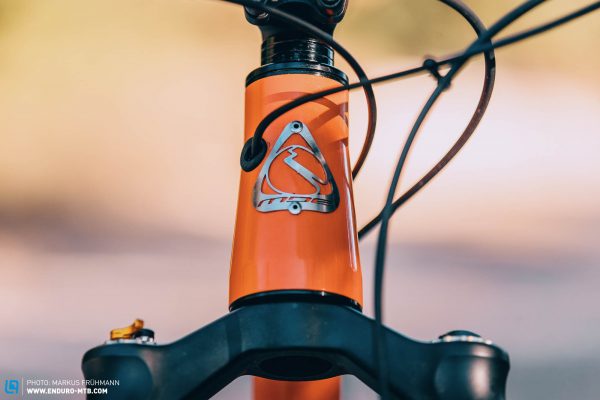
The laser cut head badge.

Customers can pick from 22 different finishes.
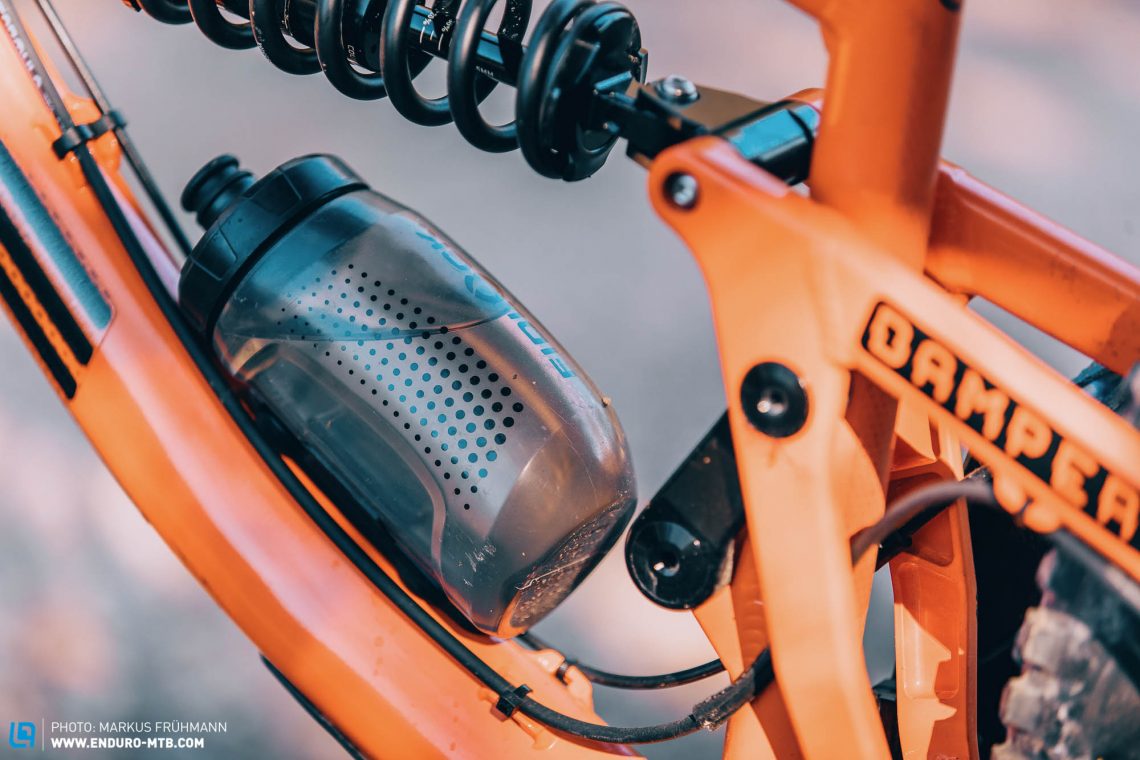
The steep seat tube allows for a comfortable climbing position and the optional FIDLOCK bottle provides refreshment (€ 30 surcharge).

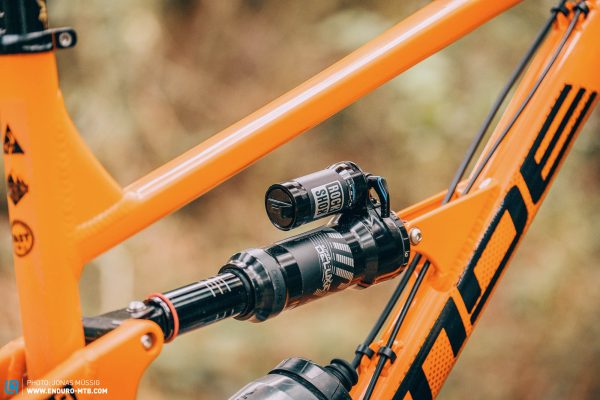
Air or coil? The DAMPER lets you choose.
The rear-end of the 2020 DAMPER has been completely overhauled. The most striking update is that the new version can take either an air or coil shock. MDE has designed the rear end of the DAMPER to be sufficiently progressive, with the leverage ratio dropping from 2.9 to 2.3 throughout the travel. Having tested the bike with both types, we would pick a coil over an air shock. While the air shock provides sufficient support and uses all of its travel, the coil is way more sensitive, generates more traction and provides more pop when pulling off ledges. For the sake of performance, we’re happy to live with the extra weight of the coil.
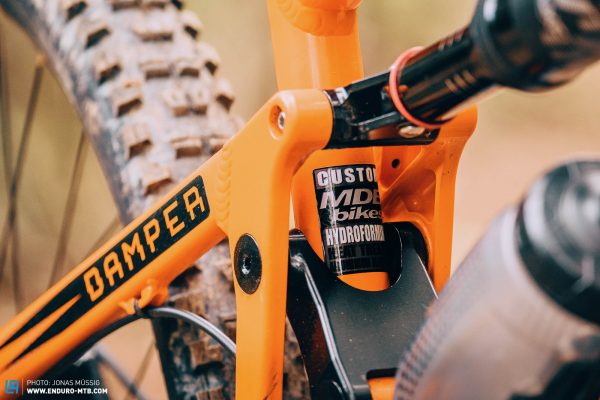
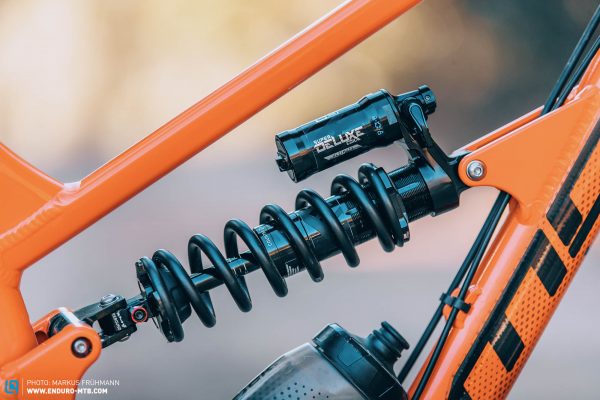
Geometry – modern yet unique.
The geometry of the DAMPER matches that of a modern enduro bike: a size L has a reach of 485 mm. The steep 77.9° seat angle and the long 442 mm chainstays alone suggest good climbing performance. The head angle is a slack 65.5° and the bottom bracket drop is 22 mm. Depending on whether you’re running 29” wheels or a mullet setup, the geometry changes. While the differences might look irrelevant on paper, the riding behaviour changes substantially on the trail.
When riding with mixed wheel sizes the shorter chainstays cause the front end to lift off on steep climbs. On top of that the smaller rear wheel doesn’t roll over obstacles as well as the bigger 29″ wheel. On downhills, the mixed-wheel setup makes it easier to lift the front wheel, which inspires confidence on steep technical terrain but also affects the overall balance of the bike. This means that on a flat trail sections you’ll have to shift your weight forward to get enough pressure on the front wheel to generate traction. The marginally slacker head angle does come in handy on steep descents though. However, overall we found the 29er configuration to be more harmonious and efficient than the mullet setup. In addition to the four frame sizes (S–XL), for an extra € 180 MDE also let you customise the geometry to your liking.

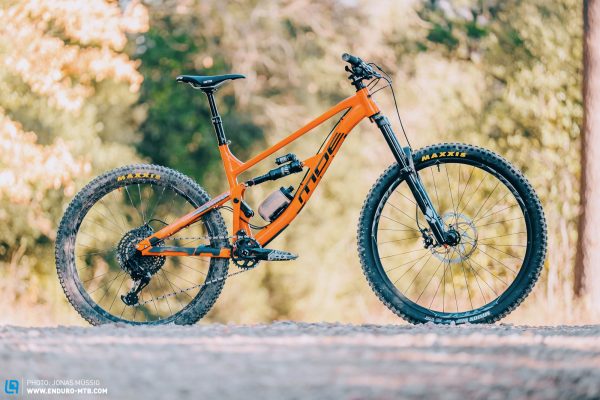
29er geometry
| Size | S | M | L | XL |
|---|---|---|---|---|
| Seat tube | 390 mm | 420 mm | 450 mm | 480 mm |
| Top tube | 565 mm | 590 mm | 615 mm | 640 mm |
| Head tube | 100 mm | 105 mm | 110 mm | 120 mm |
| Head angle | 65.5° | 65.5° | 65.5° | 65.5° |
| Seat angle | 77.9° | 77.9° | 77.9° | 77.9° |
| Chainstays | 442 mm | 442 mm | 442 mm | 442 mm |
| BB Drop | 22 mm | 22 mm | 22 mm | 22 mm |
| Wheelbase | 1,193 mm | 1,218 mm | 1,243 mm | 1,268 mm |
| Reach | 435 mm | 460 mm | 485 mm | 510 mm |
| Stack | 615 mm | 620 mm | 625 mm | 635 mm |
T29/27.5” mullet setup geometry
| Size | S | M | L | XL |
|---|---|---|---|---|
| Seat tube | 390 mm | 420 mm | 450 mm | 480 mm |
| Top tube | 569 mm | 594 mm | 619 mm | 644 mm |
| Head tube | 100 mm | 105 mm | 110 mm | 120 mm |
| Head angle | 65.0° | 65.0° | 65.0° | 65.0° |
| Seat angle | 77.4° | 77.4° | 77.4° | 77.4° |
| Chainstays | 428 mm | 428 mm | 428 mm | 428 mm |
| BB Drop | 27 mm | 27 mm | 27 mm | 27 mm |
| Wheelbase | 1,188 mm | 1,213 mm | 1,238 mm | 1,263 mm |
| Reach | 440 mm | 465 mm | 490 mm | 515 mm |
| Stack | 615 mm | 620 mm | 625 mm | 635 mm |
Spec options for the MDE DAMPER
The DAMPER will be available in two different builds. The Comp-Bike (€ 2,990) and Race-Bike (€ 3,990), or as a frame kit, where prices start at € 1,690. If you want to give it your personal touch, you can also configure the spec by choosing from a wide selection of components. The small Italian manufacturer gives its customers the option of omitting individual components, allowing them to reuse trusted components from their previous bike and thus save money. We like the idea a lot!
Our test bike was assembled with the help of the configurator tool. For this build, the focus was on Italian charm and top performance rather than light weight and exclusivity. At the time of our test, the Formula fork and brakes we had fitted weren’t available in the configurator yet. However, these should be available from February 2020.
MDE DAMPER Test-Bike
€ 4,500
Specifications
Fork Formula Selva S 180 mm
Rear Shock RS SUPER DELUXE SELECT+
Seatpost SWITCH SWR150 150 mm
Brakes Formula Cura 200/180 mm
Drivetrain SRAM GX Eagle 1x12
Stem TRUVATIV DESCENDANT 40/31.8 mm
Handlebar TRUVATIV DESCENDANT Riser Bar DH 800 mm
Wheelset PMP XL27 27.5"
Tires MAXXIS HighRoller II EXO 2.4”
Technical Data
Size S M L XL
Weight 15.56 kg



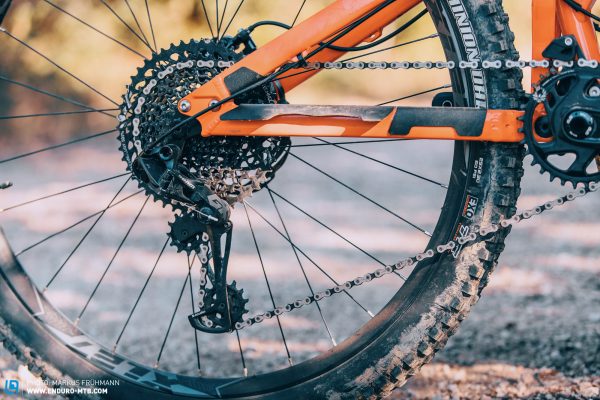
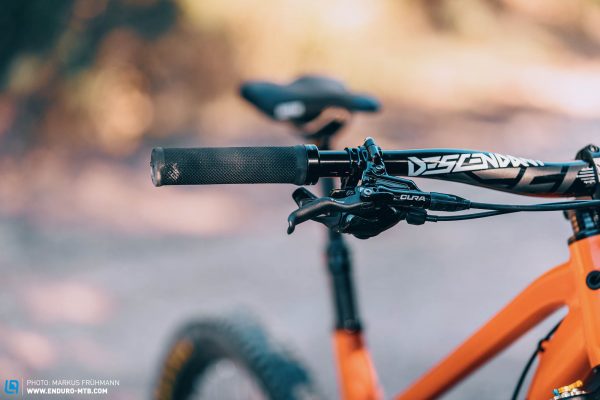
MDE DAMPER Race-Bike
€ 3,990
Specifications
Fork RS LYRIC SELECT+ 160 mm
Rear Shock RS SUPER DELUXE SELECT+
Seatpost SWITCH SWR 150/170 mm
Brakes SRAM G2 RSC 180/180 mm
Drivetrain SRAM GX Eagle 1x12
Stem TRUVATIV DESCENDANT 40/31.8 mm
Handlebar TRUVATIV DESCENDANT Riser Bar 760 mm
Wheelset PMP XL27 27.5"
Tires MAXXIS HighRoller II EXO 2.4”
Technical Data
Size S M L XL
Weight 14.20 kg
MDE DAMPER Comp-Bike
€ 2,990
Specifications
Fork RS 35 GOLD 160 mm
Rear Shock RS DELUXE SELECT
Seatpost SWITCH SWR 150/170 mm
Brakes SRAM Guide RE 180/180 mm
Drivetrain SRAM NX Eagle 1x12
Stem TRUVATIV DESCENDANT 40/31.8 mm
Handlebar TRUVATIV DESCENDANT Riser Bar 760 mm
Wheelset MDE ROVER 27.5"
Tires MAXXIS HighRoller II EXO 2.4”
Technical Data
Size S M L XL
Weight 13.20 kg

A smooth, fast climbing machine – the MDE DAMPER 29 on the trail
Straight away you’ll notice the steep seat angle even before you hit the trail. If you have to ride on flat trails before hitting a climb, the riding position feels very upright and compact but with a lot of pressure on your hands. As a result, the DAMPER gets quite uncomfortable on long, flat stretches – but then the DAMPER wasn’t designed for long rides on flat terrain. As soon as the trail gets steeper, the riding position feels a lot more comfortable, more relaxed and, above all, very centered. In this comfortable position, you’ll hardly notice any bobbing in the rear end.
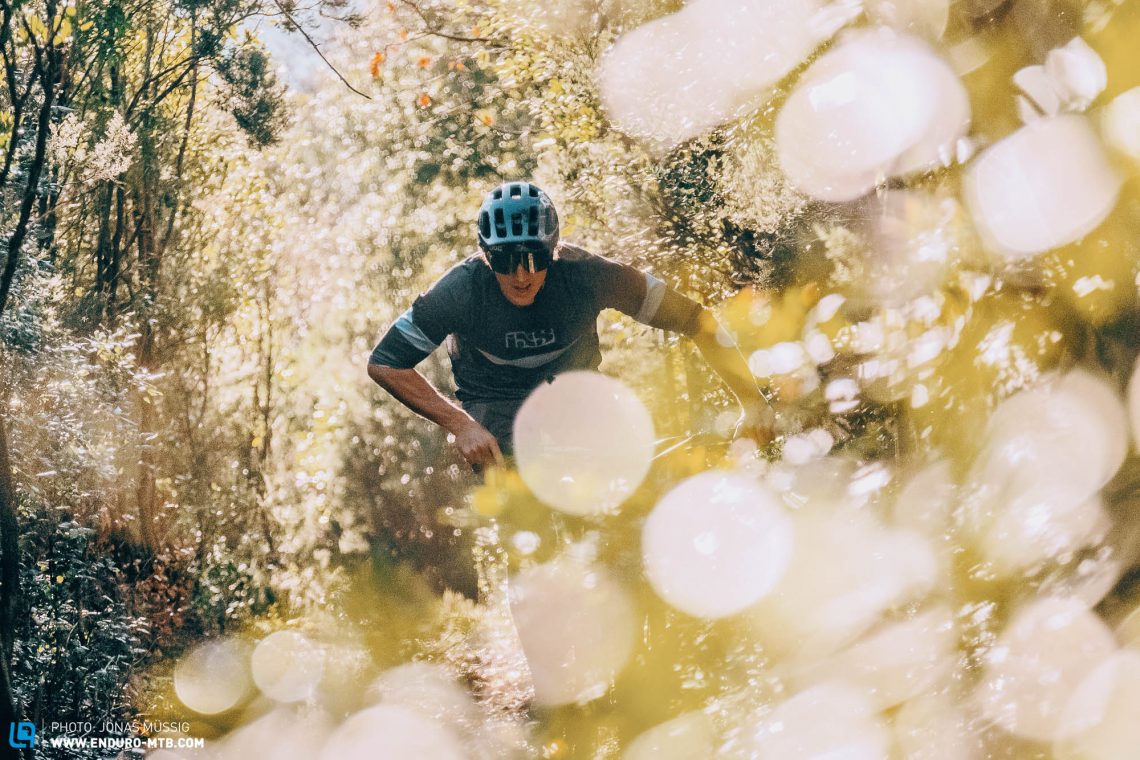
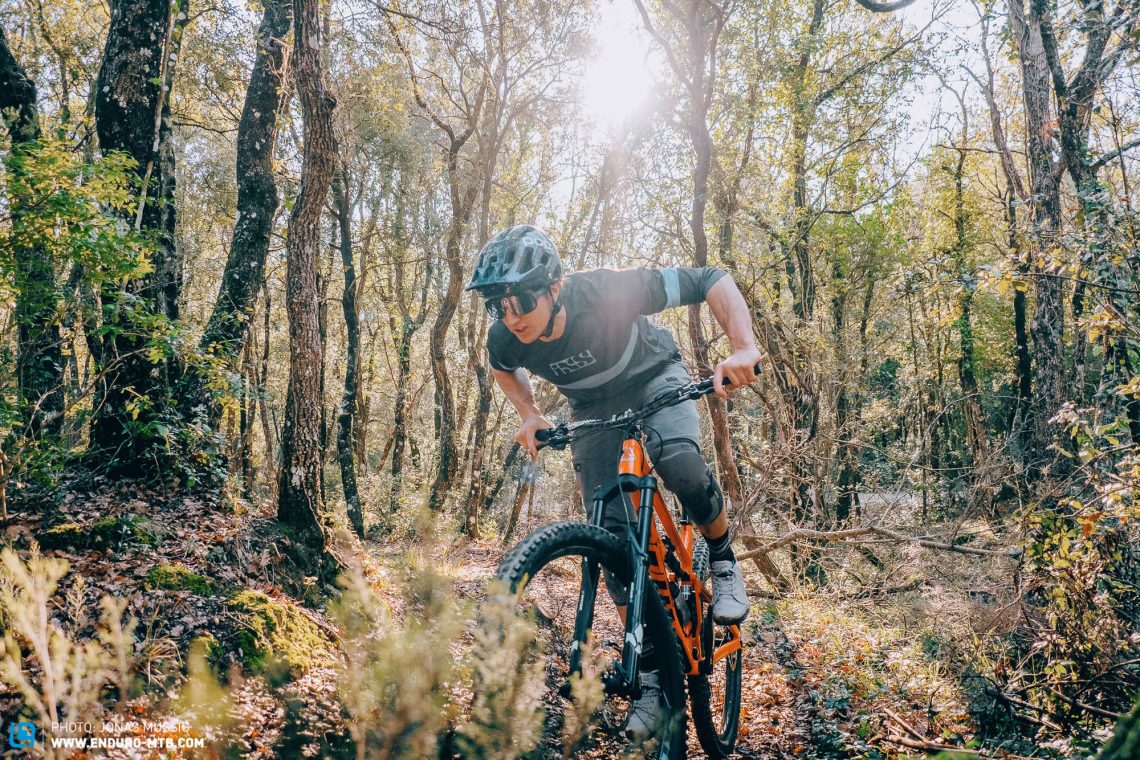
The DAMPER particularly shows its strengths on technical climbs. With the help of the sensitive rear end and the steep seat angle, it climbs eagerly and efficiently, always generating lots of traction. On long uphills, the hefty weight of 15.56 kg is its only real drawback.
Point its nose downhill and the bike feels balanced, with the geometry positioning you nicely between the wheels. The balanced weight distribution means you always have enough traction on the front wheel, without having to shift your weight too far forward, even on flat sections.
The MDE DAMPER feels most comfortable on fast and rough terrain. It’s stable, quiet and has a very sensitive rear end – you can literally float through nasty rock gardens and scary root carpets.

On top of that, the bike has plenty of reserves and the suspension never bottoms out, even with hard landings and big drops. Having said that, it does feels a little lethargic with quick direction changes and doesn’t exactly inspire creative and playful line choices.
Tuning tips: We definitely recommend the coil set-up and softer grips, as well as a dropper with more travel.
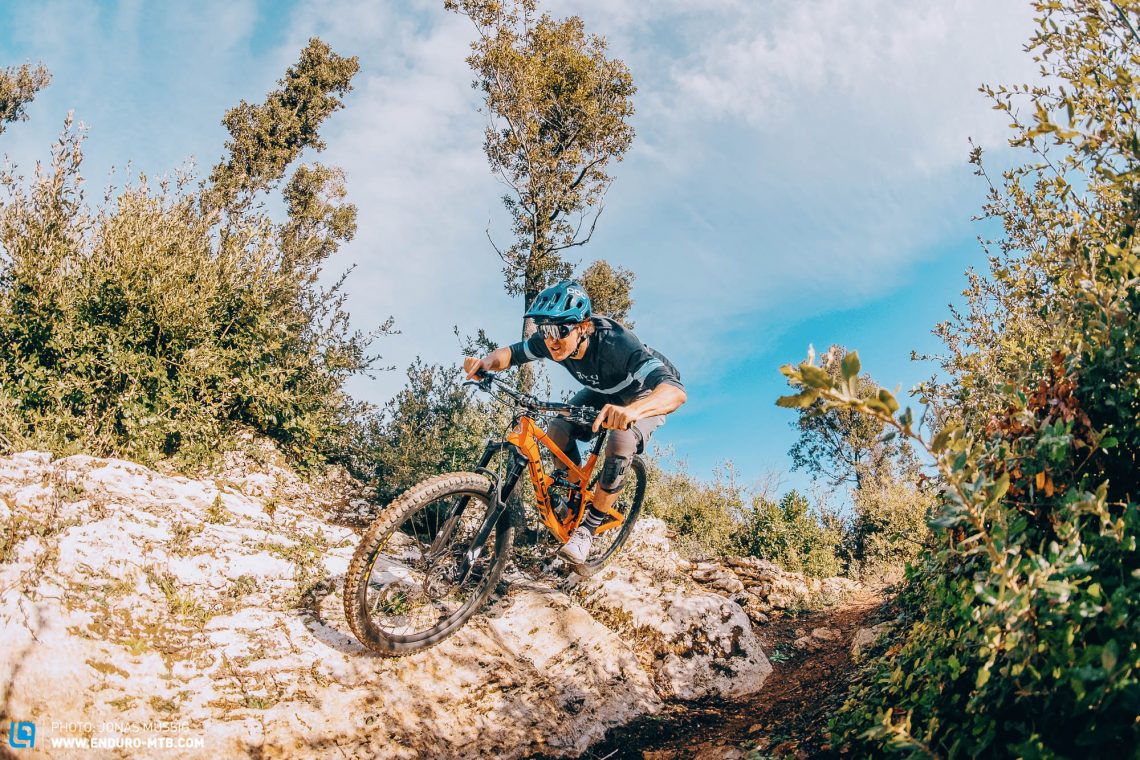
Conclusion
The MDE DAMPER is a powerful enduro bike for fast, challenging and rough trails. The progressive geometry leaves nothing to be desired, whether you’re bombing it down steeps or cruising up to the trailhead. Flowy trails and long rides with extended flat sections are not among the strengths of the DAMPER – it’s made for demanding terrain. As far as the shock configuration goes, we strongly recommend the coil setup.
Tops
- good riding position and lots of traction on technical climbs
- coil shock offers sensitivity and pop
- good value for money
- custom geometry and configurator
Flops
- too sluggish for quick direction changes
- heavy
- frame lacks attention to detail
For more information head to mdebikes.com
Did you enjoy this article? If so, we would be stoked if you decide to support us with a monthly contribution. By becoming a supporter of ENDURO, you will help secure a sustainable future for high-quality mountain bike journalism. Click here to learn more.
Words: Markus Frühmann Photos: Jonas Müssig, Markus Frühmann









